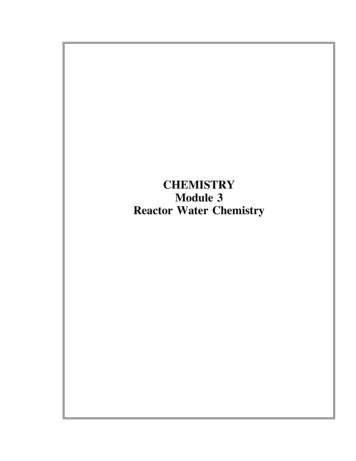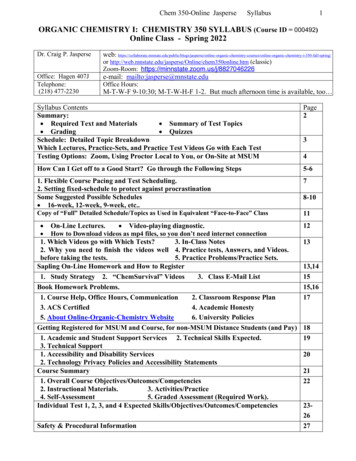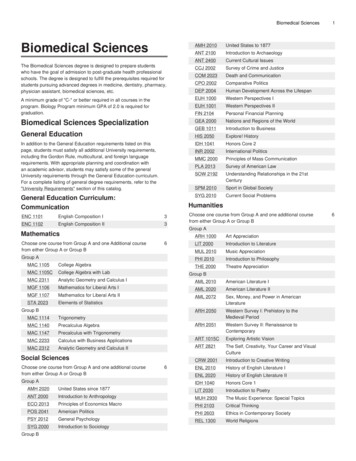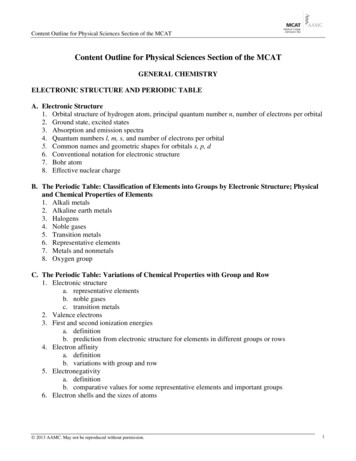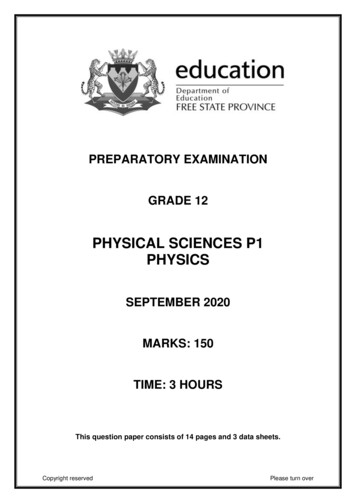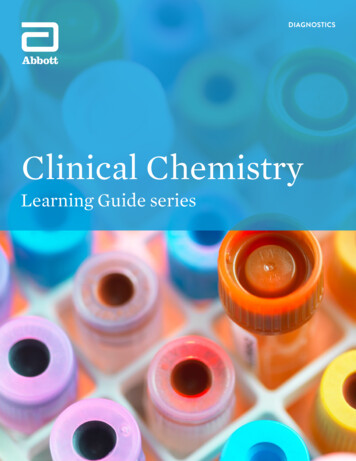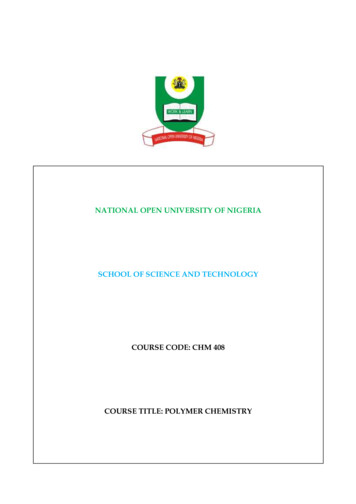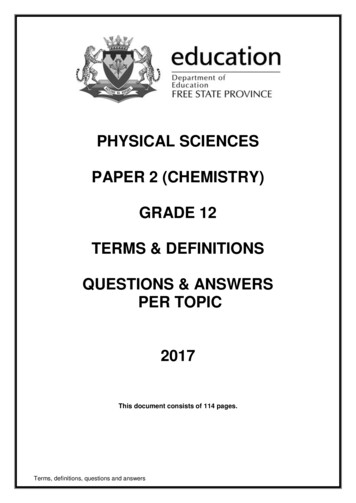
Transcription
PHYSICAL SCIENCESPAPER 2 (CHEMISTRY)GRADE 12TERMS & DEFINITIONSQUESTIONS & ANSWERSPER TOPIC2017This document consists of 114 pages.Terms, definitions, questions and answers
Physical Sciences P2 (Chemistry) Gr 122FS/2017CONTENTSHOW TO USE THIS DOCUMENT . 3TERMS AND DEFINITIONS. 4QUESTIONS . 12ORGANIC MOLECULES: NOMENCLATURE. 12ORGANIC MOLECULES: PHYSICAL PROPERTIES . 19ORGANIC MOLECULES: ORGANIC REACTIONS . 23REACTION RATE AND ENERGY IN CHEMICAL REACTIONS . 29CHEMICAL EQUILIBRIUM . 36ACIDS AND BASES . 42GALVANIC CELLS . 47ELECTROLYTIC CELLS. 53FERTILISERS . 58ANSWERS TO QUESTIONS . 63ORGANIC MOLECULES: NOMENCLATURE. 63ORGANIC MOLECULES: PHYSICAL PROPERTIES . 69ORGANIC MOLECULES: ORGANIC REACTIONS . 73REACTION RATE AND ENERGY IN CHEMICAL REACTIONS . 77CHEMICAL EQUILIBRIUM . 85ACIDS AND BASES . 95GALVANIC CELLS . 104ELECTROLYTIC CELLS. 108FERTILISERS . 111BIBLIOGRAPHY . 114Terms, definitions, questions and answers
Physical Sciences P2 (Chemistry) Gr 123FS/2017HOW TO USE THIS DOCUMENTDear Grade 12 learner1.This document was compiled as an extra resource to help you to perform well inPhysical Sciences.2.Firstly you must make sure that you study the terms and definitions provided for eachtopic. Theory always forms part of any test or examination and you should ensurethat you obtain full marks for ALL theory questions. Always be prepared to write atest on terms and definitions as soon as a topic is completed in class. Revise termsand definitions of topics already completed frequently so that you know them by thetime you are sitting for a test or an examination.3.Answer all the questions on a certain topic in your homework book as soon as thetopic is completed. DO NOT look at the answers before attempting the questions.First try it yourself. Compare your answers with the answers at the back of thedocument. Mark your work with a pencil and do corrections for your incorrectanswers. If you do not know how to answer a question, the answers are there toguide you. Acquaint yourself with the way in which a particular type of questionshould be answered. Answers supplied are from memoranda used to mark thequestions in previous years.4.Your teacher can, for example, give you two of the questions in this document ashomework. The following day he/she will just check whether you answered them andwhether you marked your answers. The teacher will only discuss those questions inwhich you do not understand the answers supplied in the document. Therefore a lotof time will be saved.5.You are probably thinking about the point behind the answers at the back of thedocument. It is intended to help you to prepare for your tests and examinations. Ifyou choose to copy answers into your homework book without trying them outyourself, you will be the losing party in the end! Not your teacher or anybody else!6.Your teacher can also decide to give you a test on one of the questions given forhomework. If you just copied the answers without any understanding, surely he/shewill catch you! None of us want to be branded as dishonest, do we?7.Work through all the questions and answers of a particular topic before you sit for anexamination, even if you answered the questions before.8.Any additional resource is only of help when used correctly. Ensure that you makeuse of all help provided in the correct way to enable you to be successful. All the bestfor 2017 and may you perform very well in Physical Sciences.Terms, definitions, questions and answers
Physical Sciences P2 (Chemistry) Gr 124FS/2017TERMS AND DEFINITIONSMATTER AND MATERIALS: ORGANIC MOLECULESAddition reactionAddition polymerAddition polymerisationAlcoholAldehydesAlkaneAlkeneAlkyl groupAlkyneBoiling pointCarbonyl groupCarboxyl groupCarboxylic acidChain isomersCondensation polymerCondensationpolymerisationCondensed ationDipole-dipole forceElimination reactionEsterificationFunctional groupFunctional isomersHaloalkane(Alkyl halide)A reaction in which a double bond in the starting material is broken andelements are added to it.A polymer formed when monomers (usually containing a double bond)combine through an addition reaction.A reaction in which small molecules join to form very large molecules byadding on double bonds.An organic compound in which H atoms in an alkane have been substitutedwith hydroxyl groups (-OH groups).General formula: CnH2n 1OHOrganic compounds having the general structure RCHO where R H oralkyl.General formula: RCHO (R alkyl group)An organic compound containing only C-H and C-C single bonds.General formula: CnH2n 2A compound of carbon and hydrogen that contains a carbon-carbon doublebond.General formula: CnH2nA group formed by removing one H atom from an alkane.A compound of carbon and hydrogen that contains a carbon-carbon triplebond.The temperature at which the vapour pressure of a liquid equalsatmospheric pressure.Functional group of ketones ( C O)Functional group of carboxylic acids (-COOH)An organic compound containing a carboxyl group (-COOH group).General formula: CnH2n 1COOH (or RCOOH)Compounds with the same molecular formula, but different types of chains.A polymer formed by two monomers with different functional groups that arelinked together in a condensation reaction in which a small molecule,usually water, is lost.Molecules of two monomers with different functional groups undergocondensation reactions with the loss of small molecules, usually waterA formula that shows the way in which atoms are bonded together in themolecule, but DOES NOT SHOW ALL bond lines.The chemical process in which longer chain hydrocarbon molecules arebroken down to shorter more useful molecules.Elimination of water from a compound usually such as an alcohol.The elimination of hydrogen and a halogen from a haloalkane.Intermolecular forces found between polar molecules i.e. molecules inwhich there is an uneven distribution of charge so that the molecule has apositive and a negative side.A reaction in which elements of the starting material are “lost” and a doublebond is formed.The preparation of an ester from the reaction of a carboxylic acid with analcohol.A bond or an atom or a group of atoms that determine(s) the physical andchemical properties of a group of organic compounds.Compounds with the same molecular formula, but different functionalgroups.An organic compound in which one or more H atoms in an alkane havebeen replaced with halogen atoms.General formula: CnH2n 1X (X F, Cℓ, Br or I)Terms, definitions, questions and answers
5Physical Sciences P2 (Chemistry) Gr 12HalogenationHomologous seriesFS/2017The reaction of a halogen (Br2, Cℓ2) with a compound.A series of organic compounds that can be described by the same generalformula.HydrationORA series of organic compounds in which one member differs from the nextwith a CH2 group.The addition of water to a compound.HydrocarbonOrganic compounds that consist of hydrogen and carbon only.HydrogenationThe addition of hydrogen to an alkeneHydrogen bondHydrohalogenationA strong intermolecular force found between molecules in which an H atomis covalently bonded to wither an N, O or F atom.The addition of a hydrogen halide to an alkene.HydrolysisThe reaction of a compound with water.Intermolecular forceLondon forceForces between molecules that determine physical properties ofcompounds.A chemical nomenclature (set of rules) created and developed by theInternational Union of Pure and Applied Chemistry (IUPAC) to generatesystematic names for chemical compounds.A weak intermolecular force between non-polar molecules.MacromoleculeA molecule that consists of a large number of atoms.Melting pointThe temperature at which the solid and liquid phases of a substance are atequilibrium.A chemical formula that indicates the type of atoms and the correct numberof each in a molecule, e.g. CH4.Small organic molecules that can be covalently bonded to each other in arepeating pattern.Chemistry of carbon compounds.A large molecule composed of smaller monomer units covalently bonded toeach other in a repeating patternA chemical reaction in which monomer molecules join to form a polymerIUPAC nameMolecular formulaMonomerOrganic chemistryPolymerPolymerisationPositional isomerPrimary alcoholCompounds with the same molecular formula, but different positions of theside chain, substituents or functional groups on the parent chain.One C atom is bonded to the C atom bonded to hydroxyl group.Example:HHHPrimary haloalkaneCOHHHOne C atom is bonded to the C atom bonded to the halogen.Example:HHHSaturated compoundsCCCBrHHCompounds in which there are no multiple bonds between C atoms in theirhydrocarbon chains.ORCompounds with only single bonds between C atoms in their hydrocarbonchains.Terms, definitions, questions and answers
6Physical Sciences P2 (Chemistry) Gr 12Secondary alcoholFS/2017Two C atoms bonded to the C atom that is bonded to hydroxyl group.Example:HHHCCHOHHCHHSecondary haloalkaneTwo C atoms bonded to the C atom bonded to the halogen.Example:HHHCCBrHHCHHStructural formulaA structural formula of a compound shows which atoms are attached towhich within the molecule. Atoms are represented by their chemicalsymbols and lines are used to represent ALL the bonds that hold the atomstogether.Structural isomerOrganic molecules with the same molecular formula, but different structuralformulae.A group or branch attached to the longest continuous chain of C atoms inan organic compound.Substituent(branch)Substitution reactionTertiary alcoholA reaction in which an atom or a group of atoms in a molecule is replacedby another atom or group of atoms.Three C atoms bonded to carbon that is bonded to hydroxyl group.Example:HHCHHHCCOHHHCHHTertiary haloalkaneThree C atoms bonded to the C atom bonded to the sVan der Waals forcesVapour pressureCompounds in which there are multiple bonds (double or triple bonds)between C atoms in their hydrocarbon chains.A combined name used for the different types of intermolecular forces.The pressure exerted by a vapour at equilibrium with its liquid in a closedsystem.Terms, definitions, questions and answers
Physical Sciences P2 (Chemistry) Gr 127FS/2017CHEMICAL CHANGE: QUANTITATIVE ASPECTS OF CHEMICAL CHANGEMoleOne mole of a substance is the amount of substance having the samenumber of particles as there are atoms in 12 g carbon-12.Molar gas volume atSTPThe volume of one mole of a gas.(1 mole of any gas occupies 22,4 dm3 at 0 C (273 K) and 1 atmosphere(101,3 kPa).Molar massThe mass of one mole of a substance.Avogadro’s LawUnder the same conditions of temperature and pressure, the same number ofmoles of all gases occupy the same volume.ConcentrationThe amount of solute per litre/cubic decimeter of solution.nIn symbols: c Unit: mol dm-3VThe simplest positive integer ratio of atoms present in a compound.Empirical formulaPercentage yieldPercentage purityPercentagecompositionLimiting reagentsSymbol: MUnit: g mol-1Yield is the amount of product obtained from a reaction.actual mass obtainedpercentage yield 100calculated massmass of pure chemical 100total mass of sampleThe percentage of each of the components in a substance.mass contribute d by componentPercentage of component 100mass of all componentsThe substance that is totally consumed when the chemical reaction iscomplete.percentage purity CHEMICAL CHANGE: ENERGY AND CHANGEHeat of reaction (ΔH)The energy absorbed or released in a chemical reaction.Exothermic reactionsReactions that release energy. (ΔH 0)EndothermicreactionsActivation energyReactions that absorb energy. (ΔH 0)Activated complexThe unstable transition state from reactants to products.Reaction rateThe change in concentration of reactants or products per unit time. cRate Unit: mol dm-3 s-1 ta model that explains reaction rate as the result of particles colliding with acertain minimum energy.A substance that increases the rate of a chemical reaction without itselfundergoing a permanent change.(A catalyst increases the rate of a reaction by providing an alternative path oflower activation energy. It therefore decreases the net/total activation energy.)The minimum energy needed for a reaction to take place.CHEMICAL CHANGE: RATE OF REACTIONCollision theoryCatalystFactors that affectreaction rateNature of reacting substances, surface area, concentration (pressure forgases), temperature and the presence of a catalyst.Terms, definitions, questions and answers
8Physical Sciences P2 (Chemistry) Gr 12FS/2017CHEMICAL CHANGE: CHEMCIAL EQUILIBRIUMOpen systemClosed systemReversible reactionChemical equilibriumFactors thatinfluence theequilibrium positionLe Chatelier'sprincipleA system which continuously interacts with the environment – it exchangesmatter and energy with its environment.A system that only exchanges energy with its surroundings, but it does notexchange matter with its surroundings.A reaction is reversible when products can be converted back to reactants.Dynamic equilibrium when the rate of the forward reaction equals the rate ofthe reverse reaction.Pressure (gases only), concentration and temperature.When the equilibrium in a closed system is disturbed, the system will reinstate a new equilibrium by favouring the reaction that will oppose thedisturbance.CHEMICAL CHANGE: ACIDS AND BASESAcid-base indicatorAmphiproticsubstance/ampholyteArrhenius theoryAuto-ionisation ofwaterConcentratedacids/basesConjugate acid-basepairConjugate acid andbaseA dye used to distinguish between acidic and basic solutions by means ofthe colour changes it undergoes in these solutions.A substance that can act as either an acid or a base.An acid is a substance that produces hydrogen ions (H )/ hydronium ions(H3O ) when it dissolves in water.A base is a substance that produces hydroxide ions (OH-) when it dissolvesin water.A reaction in which water reacts with itself to form ions (hydronium ions andhydroxide ions).Contain a large amount (number of moles) of acid/base in proportion to thevolume of water.A pair of compounds or ions that differ by the presence of one H ion.Example: CO32- and HCO3- OR HCℓ and CℓA conjugate acid has one H ion more than its conjugate base.Example: HCO3- is the conjugate acid of base CO32- .CO32- is the conjugate base of acid HCO3- .Dilute acids/basesDiprotic acidDissociationEndpointEquivalence pointHydrolysisIonisationIon product of waterIonisation constant ofwater (Kw)Ka valueKb valueContain a small amount (number of moles) of acid/base in proportion to thevolume of water.An acid that can donate two protons.Example: H2SO4The process in which ionic compounds split into ions.The point in a titration where the indicator changes colour.The point in a reaction where equivalent amounts of acid and base havereacted completely.The reaction of a salt with water.ORThe reaction of an ion with water to produce the conjugate acid and ahydroxide ion or the conjugate base and a hydronium ion.The process in which ions are formed during a chemical reaction.The product of the ions formed during auto-ionisation of water i.e.[H3O ][OH–] at 25 C.The equilibrium value of the ion product [H3O ][OH–] at 25 C.Ionisation constant for an acid.Dissociation or ionisation constant for a base.Terms, definitions, questions and answers
Physical Sciences P2 (Chemistry) Gr 12Lowry-Brønsted theoryMonoprotic acidNeutralisationpHpH scaleSaltStandard solutionStrong basesStrong acidsTitrationWeak acidsWeak bases9FS/2017An acid is a proton (H ion) donor.A base is a proton (H ion) acceptor.An acid that can donate one proton.Example: HCℓThe reaction of an acid with a base to form a salt (ionic compound) andwater.The negative of the logarithm of the hydronium ion concentration inmol·dm-3.In symbols: pH -log[H3O ]Unit: NoneA scale from 0 – 14 used as a measure of the acidity and basicity ofsolutions where pH 7 is neutral, pH 7 is basic and pH 7 is acidic.The ionic compound that is the product of a neutralisation reaction.A solution of precisely known concentration.Dissociate completely in water to form a high concentration of OH - ions.Examples: sodium hydroxide (NaOH) and potassium hydroxide (KOH)Ionise completely in water to form a high concentration of H 3O ions.Examples:hydrochloric acid (HCℓ), sulphuric acid (H2SO4) and nitric acid (HNO3)The procedure for determining the amount of acid (or base) in a solution bydetermining the volume of base (or acid) of known concentration that willcompletely react with it.Ionise incompletely in water to form a low concentration of H 3O ions.Examples: ethanoic acid (CH3COOH) and oxalic acid (COOH)2Dissociate/ionise incompletely in water to form a low concentration of OH ions.Examples:ammonia (NH3), sodium hydrogen carbonate (NaHCO3), sodium carbonate(Na2CO3), potassium carbonate (K2CO3), calcium carbonate (CaCO3)CHEMICAL CHANGE: ELECTROCHEMICAL REACTIONSGalvanic cellElectrolytic cellRedox reactionOxidationReductionOxidising agentReducing agentAnodeCathodeElectrolyteElectrolysisSalt bridgeElectrodesA cell in which chemical energy is converted into electrical energy. Agalvanic (voltaic) cell has self-sustaining electrode reactions.A cell in which electrical energy is converted into chemical energy.A reaction in which an electron transfer takes place.A loss of electrons./An increase in oxidation number.A gain of electrons./A decrease in oxidation number.A substance that is reduced/gains electrons/whose oxidation numberdecreases.A substance that is oxidised/loses electrons/whose oxidation numberincreases.The electrode where oxidation takes place.The electrode where reduction takes place.A solution that conducts electricity through the movement of ions.The chemical process in which electrical energy is converted tochemical energy OR the use of electrical energy to produce a chemicalchange.The connection between two half-cells needed to ensure electrical neutralityin the cell.ORA component used in a galvanic cell to complete the circuit.An electrical conductor used in a galvanic cell to make contact with a nonmetallic part of the circuit e.g. the electrolyte.Terms, definitions, questions and answers
Physical Sciences P2 (Chemistry) Gr 12Cell notation10FS/2017A short way to represent a galvanic cell.When writing cell notation, the following convention should be used:o The H2 H half-cell is treated just like any other half-cell.o Cell terminals (electrodes) are written on the outside of the cell notation.o Active electrodes:reducing agent oxidised species oxidising agent reduced specieso Inert electrodes (usually Pt or C):Pt reducing agent oxidised species oxidising agent reduced species PtOverall cell reactionExample: Pt Cℓ-(aq) Cℓ2(g) F2(g) F-(aq) PtThe reaction obtained by combining two half-reactions.Positive value of thestandard emfStandard conditionsfor a galvanic cellThe reaction is spontaneous under standard conditions.Standard hydrogenelectrodeThe reference electrode used to compile the Table of Standard ReductionPotentials. The hydrogen half-cell was given a standard reduction potentialof 0 V.Temperature: 25 C / 298 KConcentration: 1 mol dm -3Pressure (gases only): 101,3 kPa / 1 atmosphereHalf-cell notation: Pt H2(g) H (aq)Half-reaction: 2H 2e- H2ElectroplatingThe covering of an object with a metal by making it the cathode in anelectrolytic cell.BauxiteThe ore from which aluminium is recovered.CryoliteAn aluminium compound in which aluminium oxide is dissolved to reducethe cost of the extraction of aluminium. Cryolite has a lower melting pointthan aluminium oxide.CHEMICAL SYSTEMS: FERTILISERSNon-mineral nutrientsin plantsPrimary nutrients forplantsC, H and OObtained from the atmosphere (CO2) and rain (H2O)Nitrogen (N), phosphorous (P) and potassium (K)Function:N: essential for plant growth, green leavesP: development of roots, stems and seedsK: resistance against diseases and production of flowers/fruitsNPK fertilisersFertilisers containing the three primary nutrients for plants. They containammonium nitrate (NH4NO3), ammonium phosphate [(NH4)3PO4] andpotassium chloride (KCℓ).N : P : K ratioFractional distillationof liquid airSteam reformingThe percentage nitrogen, phosphorous and potassium in a fertiliser.Industrial preparation of nitrogen from air.Preparation of hydrogen from earth gas (methane)Reaction: CH4 H2O 3H2 COHaber processIndustrial preparation of ammoniaReaction: N2 3H2 2NH3Iron catalystTerms, definitions, questions and answers
Physical Sciences P2 (Chemistry) Gr 12Ostwald process11FS/2017Industrial preparation of nitric acidReactions:Catalytic oxidation of ammonia; catalyst:Pt 4NH3 5O2 4NO 6H2O2NO O2 2NO23NO2 H2O 2HNO3 NOContact processOR4NO2 2H2O O2 4HNO3Industrial preparation of sulphuric acidReactions:S O2 SO22SO2 O2 2SO3Contact catalyst: vanadium pentoxide (V2O5)SO3 H2SO4 H2S2O7(H2S2O7: fuming sulphuric acid OR pyro sulphuric acid OR oleum)H2S2O7 H2O 2H2SO4Preparation ofammonium sulphateammonia sulphuric acid ammonium sulphatePreparation ofammonium nitrateammonia nitric acid ammonium nitrateEutrophicationThe process by which an ecosystem, e.g. a river or dam, becomes enrichedwith inorganic plant nutrients, especially phosphorus and nitrogen, resultingin excessive plant growth. As plant growth becomes excessive, the amountof dead and decaying plant material increases rapidly.2NH3 H2SO4 (NH4)2SO4NH3 HNO3 NH4NO3Terms, definitions, questions and answers
12Physical Sciences P2 (Chemistry) Gr 12FS/2017QUESTIONSORGANIC MOLECULES: NOMENCLATUREQUESTION 1Consider the organic compounds represented by the letters A to F in the table below.AB ntan-2-onenWrite down the LETTER that represents the following:1.1.1An aldehyde(1)1.1.2A condensation polymer(1)1.1.3A compound which has a carbonyl group bonded to two carbon atoms asits functional group(1)Write down the IUPAC name of:1.2.1Compound C(3)1.2.2The monomer of compound D(1)Write down the structural formula of:1.3.1Compound A(2)1.3.2Compound F(2)The table contains compounds which are functional isomers.1.4.1Define the term functional isomer.1.4.2Write down the LETTERS that represent two compounds that arefunctional isomers.Terms, definitions, questions and answers(2)(1)[14]
13Physical Sciences P2 (Chemistry) Gr 12FS/2017QUESTION 2The letters A to F in the table below represent six organic utanoic acidHHHOHHCCCCCHCH2CH3HHHBut-2-eneDHFHCH3 HCH2CH3CCCHCH3 HHHCCHHCHCH2CH3nWrite down the:2.1.1NAME of the functional group of compound B(1)2.1.2Homologous series to which compound C belongs(1)2.1.3Type of polymerisation reaction that produces compound F(1)Write down the IUPAC name of:2.2.1The monomer used to prepare compound F(1)2.2.2Compound C(2)2.2.3Compound D(2)Write down the NAME or FORMULA of each product formed during the completecombustion of compound D.(2)Write down the structural formula of:2.4.1Compound B(2)2.4.2A CHAIN ISOMER of compound A(2)A laboratory assistant uses bromine water to distinguish betweencompounds Dand E. She adds bromine water to a sample of each in two different test tubes. Sheobserves that the one compound decolourises the bromine water immediately, whilstthe other one only reacts after placing the test tube in direct sunlight. Write down the:2.5.12.5.22.5.3Letter (D or E) of the compound that will immediately decolourise thebromine water(1)Name of the type of reaction that takes place in the test tube containingcompound D(1)Structural formula of the organic product formed in the test tubecontaining compound ETerms, definitions, questions and answers(2)[18]
14Physical Sciences P2 (Chemistry) Gr 12FS/2017QUESTION 3The letters A to F in the table below represent six organic CCHHHHHHHUse the information in the table (where applicable) to answer the questions that follow.3.13.23.3Write down the LETTER that represents a compound that:(A compound may be used more than once.)3.1.1Is a haloalkane(1)3.1.2Has a hydroxyl group as functional group(1)3.1.3Belongs to the same homologous series as ethanoic acid(1)Write down the:3.2.1IUPAC name of compound B(3)3.2.2IUPAC name of compound E(2)3.2.3Structural formula of the functional group of compound D(1)Compound C has CHAIN and POSITIONAL isomers.3.3.1Define the term positional isomer.(2)3.3.2Write down the IUPAC name of each of the TWO positional isomers ofcompound C.(4)Write down the structural formula of a chain isomer of compound C.(2)3.3.3Terms, definitions, questions and answers
15Physical Sciences P2 (Chemistry) Gr 12FS/2017Compound F reacts at high pressure and high temperature to form compounds Pand Q as given below.3.4HHHHHHHCCCCCCHHH HCompound FHHHPH HCCHHCompound QWrite down the:3.4.1Type of reaction that takes place(1)3.4.2IUPAC name of compound Q(1)3.4.3Molecular formula of compound P(1)Compound Q is the monomer of a polymer used to make plastic bags.3.4.4Write down the NAME and CONDENSED FORMULA of this polymer.(3)[23]QUESTION 4The letters A to D in the table below represent four organic compounds.AHHCH3 HCCCH3 rite down the:4.1.1Letter that represents a ketone(1)4.1.2Structural formula of the functional group of compound C(1)4.1.3General formula of the homologous series to which compound A belongs(1)4.1.4IUPAC name of compound A(3)4.1.5IUPAC name of compound B(2)Compound D is a gas used in cigarette lighters.4.2.1To which homologous series does compound D belong?(1)4.2.2Write down the STRUCTURAL FORMULA and IUPAC NAME of astructural isomer of compound D.(4)Is the isomer in QUESTION 4.2.2 a CHAIN, POSITIONAL orFUNCTIONAL isomer?(1)4.2.34.3CHCompound D reacts with bromine (Br2) to form 2-bromobutane.Write down the name of the:4.3.1Homologous series to which 2-bromobutane belongs(1)4.3.2Type of reaction that takes place(1)[16]Terms, definitions, questions and answers
16Physical Sciences P2 (Chemistry) Gr 12FS/2017QUESTION 55.1Consider the organic compounds represented by the letters A to C HHHHHCOHHHHHCCCHOHHWrite down the:5.25.1.1Name of the homologous series to which compound C belongs(1)5.1.2IUPAC name of compound A(3)5.1.3Structural formula of a tertiary alcohol that is a structural isomer ofcompound B(2)An alcohol and methanoic acid are heated in the presence of concentrated sulphuricacid to form an ester.5.2.1What is the role of the concentrated sulphuric acid in this reaction?(1)5.2.2Write down the NAME or FORMULA of the inorganic product formed.(1)The ester contains 6,67% hydrogen (H), 40% carbon (C) and 53,33% oxygen (O).The molar mass of the ester is 60 g·mol-1. Use a calculation to determine its:5.2.3Empirical formula(5)5.2.4Molecular formula(3)Write down the:5.2.5Structural formula of methanoic acid(1)5.2.6IUPAC name of the ester(2)[19]Terms, definitions, questions and answers
17Physical Sciences P2 (Chemistry) Gr 12FS/2017QUESTION 6Consider the organic compounds A to F H3)2Write down the LETTER that represents a compound that:6.1.1Has a carbonyl group(1)6.1.2Is an alcohol(1)6.1.3Is a CHAIN ISOMER of CH3(CH2)3CH3(1)Write down the:6.2.1IUPAC name of compound B(2)6.2.2Structural formula of compound F(2)6.2.3IUPAC name of a POSITIONAL isomer of compound A(3)Compound E isorganic rWrite down the:6.3.1Homologous series to which compound E belongs(1)6.3.2NAME or FORMULA of the catalyst used for the preparation ofcompound E(1)6.3.3IUPAC name of compound ETerms, definitions, questions and answers(2)[14]
18Physical Sciences P2 (Chemistry) Gr 12FS/2017QUESTION 7The letters A to F in the table below represent six organic compounds.HHHACHHCCCHBEthyl ethanoateDPolyetheneHHCE2,3-dibromo-
Physical Sciences P2 (Chemistry) Gr 12 3 FS/2017 Terms, definitions, questions and answers HOW TO USE THIS DOCUMENT Dear Grade 12 learner 1. This document was compiled as an extra resource to help you to perform well in Physical Sciences. 2. Firstly you must make sure that you

